Filipino music has a rich rhythmic heritage**, rooted in pre-colonial traditions** that featured triple meters and unique indigenous instruments like the kulintang. These traditional rhythms laid the foundation for future musical developments.
Spanish colonization introduced habanera rhythms**, which are evident in the lively harana. In contrast, the slower kundiman is characterized by 3/4 time. These influences merged with existing rhythms to create a complex soundscape**.
American and Latin influences further shaped Filipino music**, resulting in genres like Manila Sound** and P-Pop. These diverse influences created complex polyrhythms and syncopations. For example, Manila Sound combines traditional Filipino rhythms with American rock and roll, while P-Pop blends Filipino melodies with Latin American rhythms.
Indigenous Instruments and Rhythms
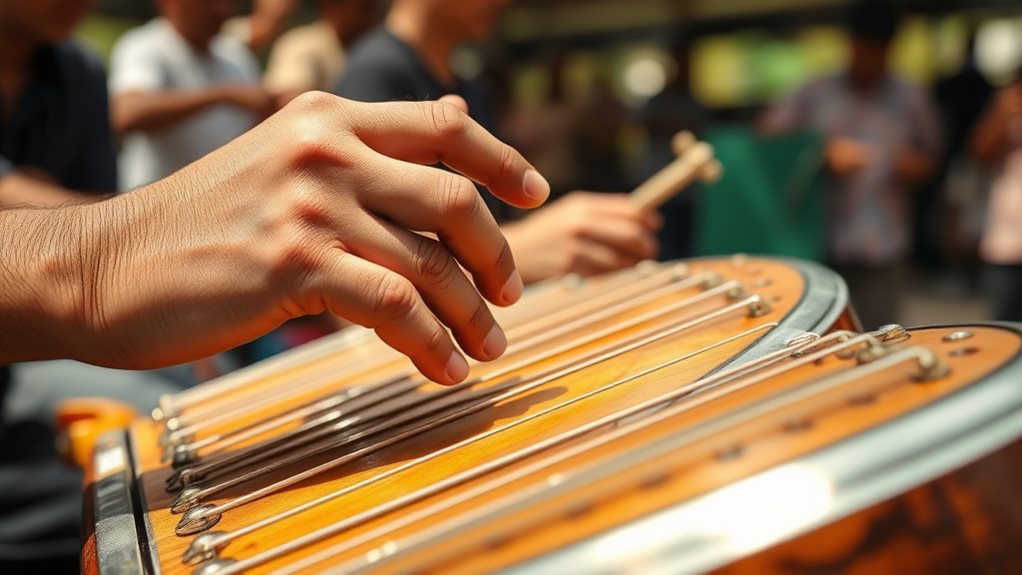
The Philippines' indigenous music is characterized by a rich diversity of sounds produced by a wide range of instruments. These instruments, such as the kudyapi and hegalong lutes, demonstrate intricate traditional construction techniques that reflect regional music variations.
The significance of indigenous rhythms lies in their roles in ceremonial music. For instance, the kulintang ensemble plays a vital role in Maguindanaoan celebrations. The kubing, a bamboo mouth harp, isn't only a musical instrument but also a tool for cultural storytelling, conveying narratives and connecting with the spiritual world.
Different regions employ distinct percussion instruments in various rituals and community music practices. The lontang, babendil, and tamuli ensembles showcase this diversity.
Instrument tuning techniques also vary across regions, influencing the overall sound. The two-stringed binarig and faglong, for example, demonstrate the minimalist yet expressive nature of some instruments.
Folk music preservation efforts are crucial for maintaining the unique sounds of these instruments and their associated rhythms. The significance of rice-planting rituals, signaled by instruments like the kulibit drum and gangsa gongs, highlights the embedded cultural significance of music in daily life.
Spanish Colonial Rhythmic Influence
Spain's three-century colonization of the Philippines had a profound impact on the country's musical landscape. This influence resulted in a unique blend of indigenous and Western rhythmic traditions. The adaptation of traditional music during this period showcases this rhythmic fusion.
Spanish music introduced structured forms and harmonies, which clashed with yet blended with existing folk influences. This cultural assimilation led to the emergence of rhythmic diversity. For instance, Spanish rhythms infiltrated existing musical structures, creating new syncopations and polyrhythms. This is evident in the evolution of musical styles, where Western instruments like the guitar and organ were integrated into traditional ensembles, producing new sounds.
The following table highlights key aspects of this rhythmic transformation:
| Spanish Influence | Filipino Adaptation |
|---|---|
| Introduction of Western instruments (guitar, organ) | Integration into existing ensembles, creating new sounds |
| Emphasis on structured forms | Adaptation of Western forms to indigenous melodic structures |
| Introduction of Western harmonies | Blending of Western harmonies with existing scales |
| Polyphony and Gregorian Chant | Incorporation into religious and secular music |
This musical evolution resulted in a rich tapestry of rhythmic patterns. The Spanish heritage, initially imposed, eventually became interwoven with the indigenous musical fabric. This is evident in the rhythmic complexities often found in contemporary Filipino music, a testament to the enduring legacy of colonial rhythmic exchanges. Rhythmic diversity is a critical component of the Philippines' rich musical identity.
Rhythms of the Harana and Kundiman

Filipino Musical Heritage: Harana and Kundiman****
Filipino music boasts two prominent genres, the harana and kundiman, each with unique rhythmic characteristics.
Harana: Lively and Danceable
The harana has a lively, almost danceable quality, reflected in its 2/4 habanera rhythm. This rhythm originated from Spanish folk music and is often performed at night by a group of serenaders.
Nocturnal performances are characteristic of the harana, which is typically used for courtship serenades.
Kundiman: Slow and Melancholic
In contrast, the kundiman employs a slower 3/4 time signature, lending itself to the expression of deeper emotions.
Kundiman's waltz-like rhythm** is perfect for conveying longing and melancholy**. This slower pace accentuates the introspective and often sorrowful themes explored in kundiman lyrics.
Key Differences
Rhythm: The harana's rhythm is upbeat and suitable for a courtship serenade, while the kundiman's rhythm is slower and more melancholic.
Lyrics: Harana lyrics are often straightforward declarations of affection, while kundiman lyrics explore complexities of unrequited love.
Instrumentation: Both genres frequently utilize the guitar, but the overall mood and tempo differ significantly.
Emotional Landscapes
Analyzing these rhythmic differences helps us understand the distinct emotional landscapes each genre evokes.
The harana's vivacious rhythm complements its celebratory nature, while the kundiman's more deliberate pace accentuates its introspective and often sorrowful themes.
This contrast underscores the richness and diversity within Filipino musical expression.
Similarities
Both genres originated during the Spanish colonial period and frequently utilize the guitar as the main instrument.
Exploring Traditional Dance Rhythms
Traditional Filipino Dances: A Rich Tapestry of Rhythms
Beyond the romantic rhythms of harana and kundiman, traditional Filipino dances showcase a rich cultural heritage. Each dance has a unique rhythmic structure, reflecting cultural narratives and beliefs. Regional variations add complexity, highlighting the archipelago's diverse heritage.
The Cariñosa, a Spanish-influenced dance, portrays courtship through subtle movements and the use of fans. The Pandanggo sa Ilaw, also of Spanish origin, involves balancing lamps, adding a visual element to its rhythmic complexity. In contrast, the Tinikling, originating in Leyte, showcases athleticism through its use of bamboo poles, mimicking the movements of the tikling bird. Its dynamic rhythms demand precision and skill.
Characteristics of Traditional Filipino Dances
| Dance | Origin/Symbolism | Rhythmic Characteristics |
|---|---|---|
| Cariñosa | Spanish influence, courtship | Subtle, elegant movements |
| Pandanggo sa Ilaw | Spanish influence, balance, skill, religious ritual | Intricate footwork, lamp balancing |
| Tinikling | Leyte, Visayas; mimicking the tikling bird | Fast-paced, percussive, precise footwork |
Regional Variations and Symbolism
Further exploration reveals dances like the Maglalatik (Biñan, Laguna), which represents a tribal battle using coconut shells rhythmically. The Itik-itik (Surigao del Sur) mimics duck movements with quick, side-to-side steps. The Singkil (Lake Lanao) is a Maranao epic narrative known for its intricate footwork and bamboo poles. These dances, with their specific regional variations, offer a glimpse into the breadth and depth of Filipino rhythmic traditions. The dance symbolism and regional variations are intrinsically linked to the dances' rhythmic structures, enhancing their artistic and cultural impact.
Pre-Colonial and Syncretic Forms
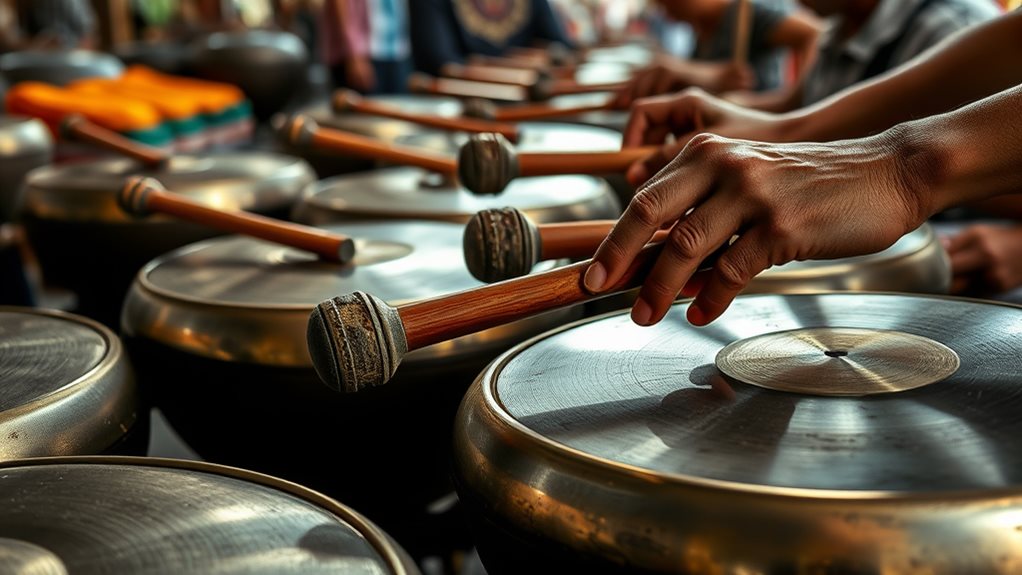
Pre-colonial musical traditions in the Philippines were rich and diverse. In the archipelago, indigenous musical traditions thrived before the arrival of colonizers. The *kutiyapi*, a plucked string instrument from Mindanao and the Visayas, the *kulintang*, a set of bronze gongs from the southern islands, the *luntang*, a percussion instrument crafted from various materials, and the *tongatong*, a bamboo or wood instrument used in rituals, are examples of these traditions.
The syncretic evolution of Filipino music resulted from the blending of indigenous and foreign influences. The *kundiman*, with its triple meter and characteristic shift in key, demonstrates a pre-colonial foundation adapted to colonial contexts. The *harana*, rooted in Spanish traditions, reflects a different rhythmic influence entirely.
The *rondalla*, a plucked string ensemble, showcases a clear Spanish colonization influence, yet it has become distinctly Filipino through adaptation and local compositions.
The syncretic process involved reinterpretation and reimagining of existing rhythms, creating something uniquely Filipino. Analyzing these forms reveals how pre-colonial rhythmic foundations interacted with imported musical practices.
The resulting hybrid forms highlight a dynamic cultural exchange and the enduring power of indigenous rhythmic foundations within a constantly evolving musical landscape. Understanding this interplay is critical to fully appreciating the complexity and richness of Filipino musical heritage.
The Impact of Latin Rhythms
Latin Rhythms Shaped Filipino Music****
Latin rhythms significantly impacted the evolution of Filipino music, leaving an indelible mark on numerous genres.
The harana, a traditional courtship song, is deeply rooted in Mexican-Spanish habanera and danza rhythms. The kundiman, with its pre-colonial origins, often employs a triple meter rhythm, showcasing this rhythmic fusion.
Filipinos Adapted Latin Rhythms****
This wasn't simply imitation; Filipinos deliberately adapted Latin rhythms.
They slowed the danza's tempo and paired it with Tagalog poetry to create unique expressions of courtship. This cultural integration, mirroring processes in other Latin American nations, resulted in distinct genres. For example, the tango and mariachi reflect how foreign rhythms were indigenized.
Rhythmic Fusion in Modern Filipino Music
The influence of Latin rhythms persists in modern Filipino music (OPM).
Groups like VST & Company showcased this Latin influence in the 1970s and 80s, paving the way for contemporary musicians to experiment with these rhythms. They blended them with other styles to create a dynamic and diverse musical landscape.
The Latin legacy is an integral part of Filipino musical identity.
Jazz and American Influences
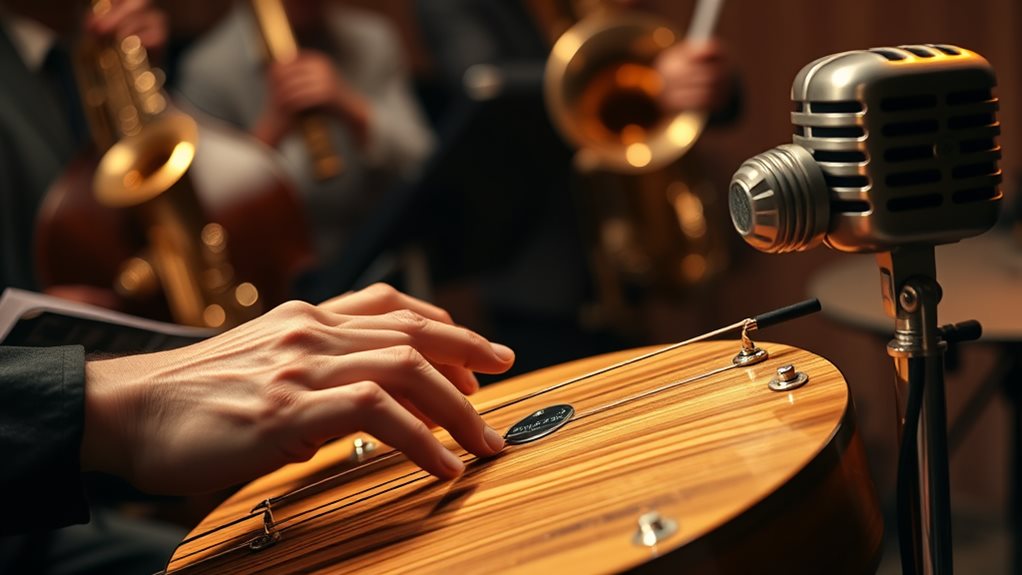
The interplay between Filipino and American music is multifaceted and reciprocal.
Filipino American musicians have made significant contributions to American genres. For instance, musicians like Bruno Mars, who's of Filipino descent, have successfully blended pop, rock, and R&B to create a unique sound. This fusion of styles has enriched American music and demonstrates the influence of Filipino culture on American genres.
American instrumentation has been incorporated into popular Filipino music. The use of electric guitars, drums, and saxophones in Filipino rock, pop, and jazz bands is a testament to this influence. This blending of instrumentation has resulted in a distinctive sound that's both Filipino and American.
The American hippie movement has inspired Filipino artists. The movement's emphasis on free expression, nonconformity, and social activism has influenced Filipino artists' themes and styles. For example, Filipino folk rock musicians like Joey Ayala and Gary Granada wrote songs that promoted social change and activism, reflecting the ideals of the hippie movement.
Jazz improvisation techniques have been incorporated into Filipino compositions and performances. Filipino jazz musicians like Lea Salonga and Mon David have successfully integrated jazz improvisation into their music, creating a unique blend of Filipino and American jazz styles.
This fusion of styles has enriched the Filipino music scene and demonstrates the reciprocal influence of American music on Filipino culture.
Pinoy Jazz and Dance Crazes
American influences shaped a unique Filipino sound** during the early to mid-20th century, culminating in the vibrant fusion of Pinoy jazz** and dance crazes. This period saw the blending of Afro-American and Hispano-Filipino musical traditions, which originated from the American occupation.
Luis Borromeo popularized ragtime**, while composers like Francisco Santiago and Jose Estella integrated jazz into classical forms. This musical fusion gave birth to new dance genres**, such as the "himno one-step," "Filipino foxtrot," and "Filipino tango-foxtrots," showcasing the rhythmic diversity of this cultural expression.
The jazz evolution thrived in performance venues like Manila's Escolta district, where the recording industry, particularly labels like Parlophone, played a crucial role in disseminating these new sounds.
Atang de la Rama and Sylvia La Torre popularized Filipino dance records****, significantly impacting the historical significance of this era.
Angel Peña's 1950s work exemplified the unique fusion of Filipino folk music with jazz**. Later, Eddie Munji and Ryan Cayabyab further shaped Pinoy jazz in the 1970s. This blend of international and local styles created a vibrant cultural expression**, reflecting the Philippines' pluralistic society and preserving precolonial musical forms.
This period profoundly influenced later generations of Filipino musicians and composers, shaping the country's music scene for years to come.
The Rise of Filipino Jazz

The Rise of Filipino Jazz****
Filipino jazz originated from early 20th-century interactions with African-American soldiers and Filipino immigrants in the US. However, it flourished during the 1920s Jazz Age and beyond, significantly influenced by cultural exchange.
Early exposure to jazz came through American settlers and Filipino musicians performing on Pacific liners, showcasing their talent internationally. The big band era of the 1930s-50s saw the rise of legendary figures like Ping Joaquin and Federico Elizalde, solidifying Filipino Jazz's regional presence. Their musical collaborations spread the genre across Asia.
Filipino jazz is a fascinating blend of influences. Historical roots intertwine with American Jazz styles, while a distinct Filipino sound emerged later.
Post-1950s Era Innovations
The post-1950s era witnessed the innovative fusion of jazz with Filipino folk music, a pivotal moment in the genre's artistic innovation.
Bob Aves played a crucial role in integrating traditional instruments, creating a unique Philippine sound. The "Igorot Jazz Fantasy" exemplifies this fusion of styles, highlighting the influence of folk music on Filipino Jazz. This period involved collaborations with musicians from diverse regions, resulting in a richer, more nuanced sound.
Legacy and Global Presence
The legacy of Filipino Jazz continues through university ensembles and global performances, demonstrating the ongoing evolution of the genre.
Filipino Jazz thrives through continued artistic innovation and its presence at Jazz Festivals worldwide, cementing its place in the global music scene.
Colonial and Cultural Impacts
Filipino Music's Evolution: A Blend of Indigenous and Colonial Influences****
Filipino music's evolution is a testament to the interplay between indigenous traditions and colonial influences. The Spanish colonization introduced Western musical forms, integrating music into church ceremonies and subtly displacing local traditions. This led to the emergence of hybrid genres like the kundiman and habaneras, blending Western melodies with native styles, reflecting heartache, longing, and even nationalist sentiments.
The persistence of indigenous instruments like the kulintang and gandingan alongside religious themes in early compositions, such as the "Passion Salve", showcases this fascinating musical evolution.
The American influence followed, with music becoming a formal part of the educational curriculum. American popular genres like blues, jazz, and rock and roll profoundly shaped the local music scene and established music as entertainment.
Filipino performers adapted these genres, creating a uniquely Filipino sound through the use of Tagalog lyrics. This cultural synthesis resulted in new genres and the blending of languages.
The sarswela, adapted from the Spanish zarzuela, became a vehicle for protest, while the kundiman reflected the Filipino experience. This process of integrating local content and themes into Western forms helped define a unique cultural identity, evident in the ongoing hybridization of OPM.
The use of indigenous aesthetics in modern OPM represents a continuing musical evolution and a dynamic interplay between external influences and a strong expression of cultural identity.
Music as Cultural Resistance
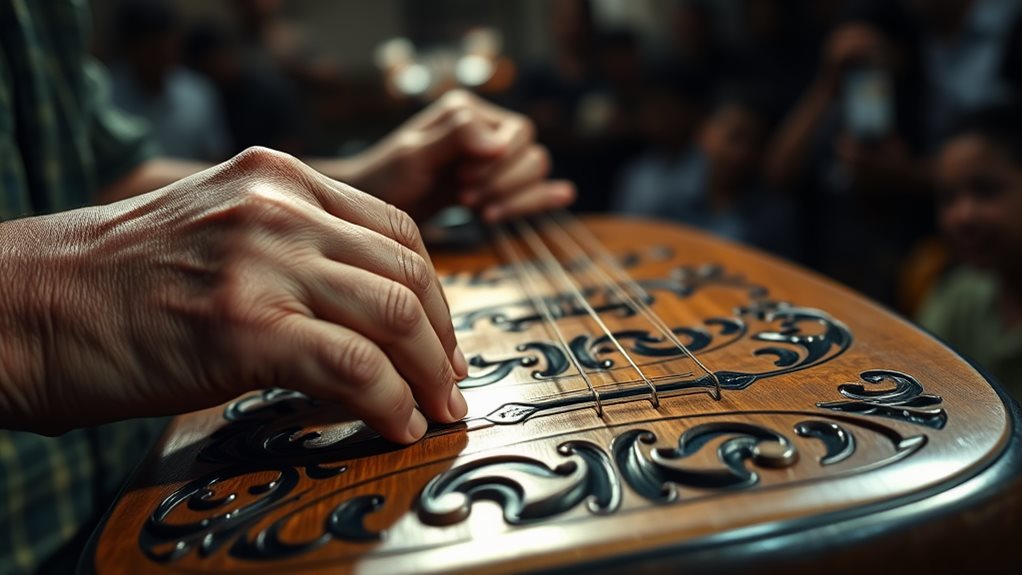
Music and Dance as Cultural Resistance
Throughout Philippine history, music and dance have served as powerful tools of cultural resistance against colonial powers. Traditional instruments like the kulintang, luntang, babendil, and tongatong played crucial roles in preserving cultural identity amidst colonial pressures. These instruments, with their unique regional variations, reflect a rich rhythmic heritage passed down through generations, resisting assimilation.
Folk Dances as Expressions of Cultural Resistance
Folk dances have also served as powerful expressions of cultural resistance. The tinikling, while showing Spanish rhythmic influence, ultimately showcases Filipino resilience. For instance, The singkil, with its royal-inspired gestures, preserves pre-colonial beliefs and Mindanao's rich cultural heritage.
Additionally, the pandanggo sa ilaw, a fusion of Spanish and indigenous elements, demonstrates the dynamic interplay between historical narratives and artistic expression. Regional variations in dance steps highlight the diverse cultural influences and historical experiences across the archipelago.
Indigenous Music and Cultural Resistance
Indigenous music, integral to daily life events and rituals, further underscores this cultural resistance. Instruments like the kulintang and babendil, central to ceremonies, preserve cultural practices and community bonds.
The fluid, microtonal continuum of indigenous music contrasts sharply with Western musical traditions, reinforcing the distinct Filipino rhythmic heritage and cultural identity. This musical continuity, evident in contemporary performances, illustrates the enduring legacy of Filipino cultural resistance.
Modern Filipino Music Styles
The Philippine music scene has undergone significant changes since the mid-20th century, resulting in diverse modern styles that reflect both local cultural heritage and global influences.
The Manila Sound**, a notable movement that emerged in the mid-1970s, fused rock music with local languages, primarily Tagalog**. Bands like Hotdog and Juan Dela Cruz Band pioneered this style, blending Tagalog and English lyrics, known as "Taglish," to create a distinctly Filipino sound influenced by folk music and diverse cultural threads.
In the 2010s, Pinoy Pop (P-Pop) experienced a resurgence, heavily influenced by K-pop, J-pop, and EDM. This genre is characterized by its embrace of idol groups and Asian-style ballads, reflecting the country's economic and cultural growth. Artists like SB19, BINI, and Moira Dela Torre exemplify P-Pop's vibrant energy and widespread appeal.
Pinoy Jazz, which originated during the American occupation, also saw a revival. This genre showcases a harmonious blend of Filipino folk and jazz elements, highlighting the vibrant interplay of traditional and contemporary influences that continue to shape the Filipino soundscape.
Contemporary music often features dissonant harmonies and complex rhythms, with percussiveness being a notable trait. Themes frequently center on love, loneliness, and despair, with fewer lyrical melodies compared to past periods.
Global Reach of Filipino Music
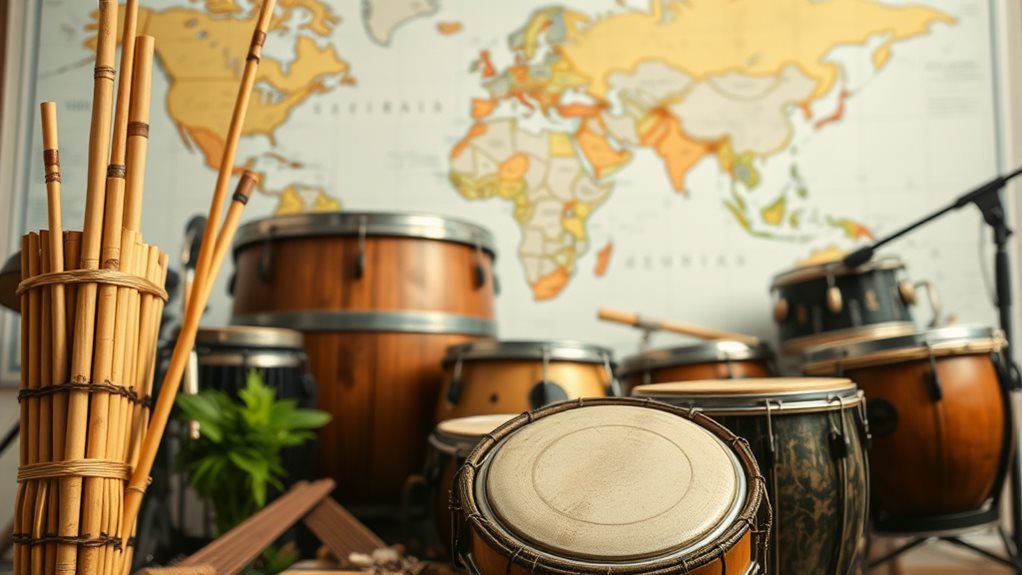
Filipino Music's Global Reach****
Over the past decade, Filipino music has gained significant international recognition, driven by the rise of digital platforms, the growing popularity of P-Pop, and individual artists' success in penetrating global markets.
SB19 and Bini are examples of artists with massive global fanbases. Spotify's targeted programs, such as "Radar" and "Glow," have accelerated this growth.
The Philippines as a "Trigger Market"
The Philippines, along with Indonesia, acts as an early adopter of global music trends, indicating what'll soon hit North America.
This early adoption significantly impacts an artist's international trajectory**. Filipino music's global success isn't isolated; the high engagement with foreign music** within the Philippines (95% of listeners engage with international content) creates opportunities for collaborations and integration into international festivals.
Key Points
1. Filipino artists are achieving significant traction globally, with success in the USA, Canada, Japan, and Southeast Asia.
2. The economic impact is substantial, with projections showing significant growth in the Philippine music streaming market.
3. Spotify's data highlights the Philippines' role as a crucial indicator of global music trends.
4. The openness of Filipino listeners to diverse musical styles contributes to the global diversification of music consumption.
Implications for Filipino Artists
This evolving landscape offers exciting possibilities for Filipino artists eager to participate in the global music industry.
Their success reflects not only individual talent but also the strategic use of digital platforms and leveraging "trigger markets" like the Philippines.
Questions and Answers
How Does Filipino Rhythm Relate to Body Percussion?
Filipino body rhythm is an essential element of cultural expression. In traditional Filipino music, body percussion plays a significant role in enhancing the overall feel of the songs. Claps, snaps, and pats are commonly used to create complex, syncopated patterns. For instance, in the traditional Filipino song "Tinikling," dancers use claps and foot taps to create a lively rhythm. This integration of body rhythm with music highlights the importance of physical expression in Filipino culture.
What Are Common Time Signatures in Filipino Music?
Common time signatures in Filipino music include 2/4, 3/4, and 4/4. These meters are often influenced by traditional instruments and dance, which impact the rhythmic complexity of the music. The 6/8 time signature is less frequent but still present.
Do Rhythmic Patterns Vary by Region in the Philippines?
Rhythmic patterns in the Philippines vary significantly by region. This variation is a result of diverse regional influences that have shaped the cultural significance of rhythmic patterns throughout the country's history and geography. For instance, the southern region of Mindanao has been influenced by Islamic and indigenous cultures, resulting in rhythmic patterns that are distinct from those found in the northern region of Luzon, which has been influenced by Spanish and American cultures. Regional rhythmic patterns reflect the unique cultural heritage of each area in the Philippines.
How Has Technology Impacted Filipino Rhythmic Innovation?
Technology has revolutionized Filipino rhythmic innovation by introducing new stylistic influences and production capabilities. With global connectivity, Filipino musicians can now access and incorporate diverse rhythms and beats from around the world into their music. Advanced production software has enabled them to experiment with unique sound combinations and effects, resulting in innovative rhythmic expressions. For instance, Filipino artists can blend traditional Kundiman melodies with electronic dance music (EDM) beats, creating a distinctive fusion sound. This digital fusion has opened up new avenues for creative expression and has transformed the sound of contemporary Filipino music.
What Are Some Lesser-Known Rhythmic Traditions?
Lesser-known rhythmic traditions can be found in bamboo instruments used in traditional dances. These instruments, such as the Angklung from Indonesia and the Kulintang from the Philippines, are integral to cultural celebrations and ceremonies. In traditional dances, the rhythmic patterns and beats are woven into the movements, telling stories and conveying emotions. For example, the Angklung's rhythmic patterns are used to depict the struggles and triumphs of everyday life, while the Kulintang's complex rhythms evoke the bravery and honor of ancient warriors.